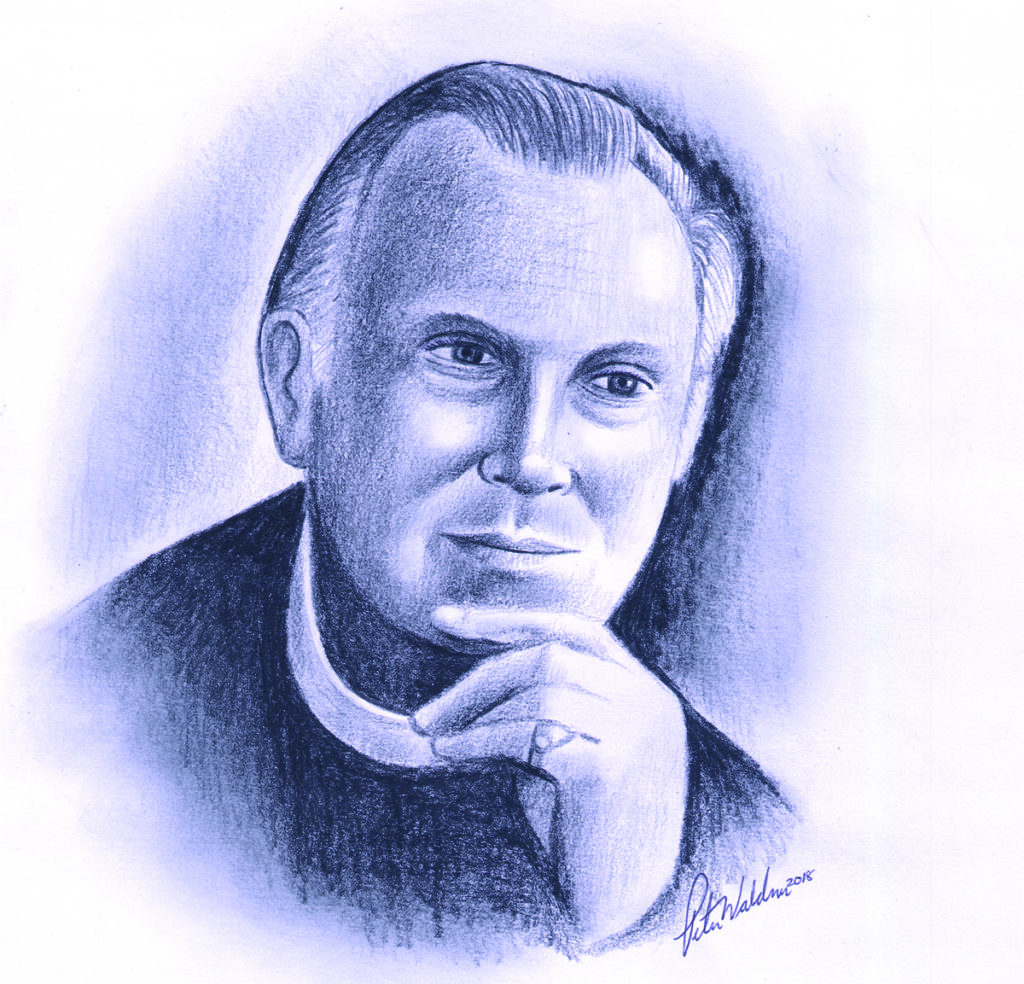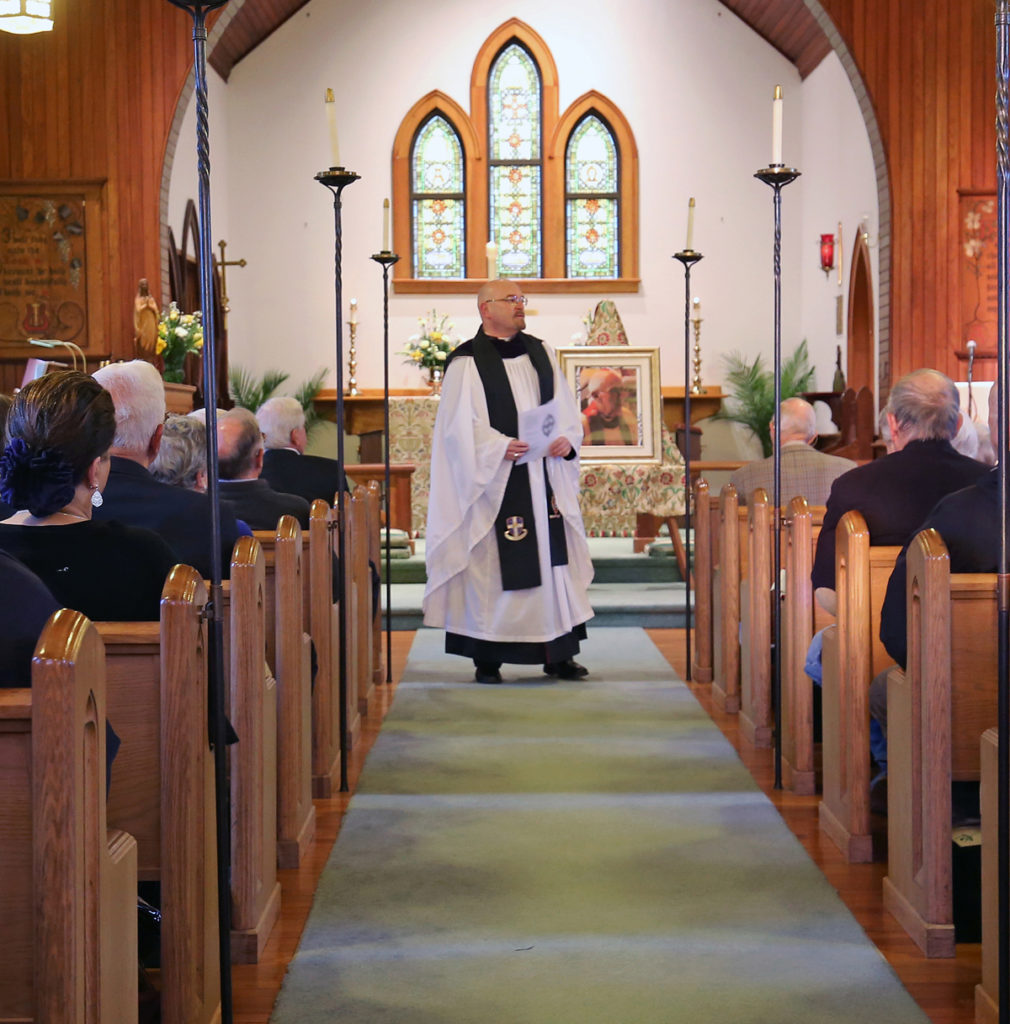Shelter Island mystery: Wancura investigation two years on with no resolution

He thought he was prepared for the worst. But what Father Charles McCarron discovered, checking on an elderly friend and colleague one midday two years ago, was a horrific and heartbreaking crime, something he said he could never have prepared for.
A CRIME THAT IS STILL UNSOLVED
“It’s been kind of like a PTSD event for me,” Father McCarron, the pastor of St. Mary’s Episcopal Church, said last week.
That bright, windy March day, he had gone to the Reverend Canon Paul Wancura’s home in Silver Beach. The retired 87-year-old Episcopal minister had been absent for Sunday services at a church in West Islip where he had assisted most weekends. The widowed churchman, who had no living close relatives, had not answered his phone or responded to messages.
“It was remarkable, even at 87, that he never missed a service, driving there every Sunday,” Father McCarron said. “Something was wrong.”
He entered the waterfront house on Oak Tree Lane, the one-lane road that leads to Shell Beach, through the garage door, which the Rev. Wancura had a habit of leaving open.
“Knowing his age, I was prepared to find that he might have fallen, or was ill,” Father McCarron said. “But not what I found.”
The elderly minister was in a bedroom, trapped in a corner in a heap between the bed and a wall, with his wrists tightly bound. It was determined that he had been in that state from three to seven days, Shelter Island Police Chief Jim Read said. The Rev. Wancura was airlifted to Stony Brook University Hospital and placed in the intensive care unit.
He never left it.
We’ve run every lead down, and everything that comes in, we run it down. We want to bring this in.
Det. Lt. Kevin Beyrer, SCPD
After enduring multiple blood transfusions and the amputation of his left hand, the venerable priest succumbed to his wounds on April 16, 2018, just short of a month after being found. The official cause of death was sepsis, which is a system-wide infection, usually caused by injuries.
He was lucid and his own personable self during his time in the ICU, Father McCarron and others said, receiving friends and colleagues at his bedside. At times he rallied, giving hope he’d pull through. But being tied up for days, immobile against a wall, had been too much for the nearly 90-year-old man.
A visitor to the hospital, a veteran of Vietnam, said he had never seen such serious wounds since his service in the war.
The crime has been characterized as the worst in the Island’s history.

‘ACTIVE’
Over the past two years, there have been no arrests, and no suspects identified. The Shelter Island Police and the Suffolk County Police departments have designated the crime as a home invasion, burglary — several items of jewelry were stolen — and a homicide. Both departments say the investigation is “active.”
Adding to the mystery, is that soon after Father McCarron’s discovery of the Rev. Wancura, the police reported another burglary on Oak Tree Lane they estimated occurred on the afternoon of March 4, when the owners “returned after being away for an extended period of time,” Chief Read said at the time. “Detectives are exploring the possibility that the burglary and the discovery of a burglary two weeks ago in the same area might be connected.” The chief added that the second incident is “broadening the scope of looking at suspects.”
About a month after the first reports of the incident surfaced, the police released a description and photograph of one of the items stolen from the Rev. Wancura’s residence, a Lucien Piccard Seashark watch. A $10,000 reward for information leading to the arrest of the killer or killers has been posted for two years. Anyone with information is urged to phone 1-800-220-TIPS.
Chief Read, within a few days of the reports from Oak Tree Lane, said it was “not a random incident.” Detective Lieutenant Kevin Beyrer, commanding officer of the Suffolk County Police’s homicide squad, confirmed last week that assessment is still the belief of the investigators.
“There were elements of the crime that led us to believe that, whoever did this, planned it and knew what they were doing going into it,” Det. Beyrer told the Reporter. “We don’t believe that the person or persons who did this thought they were going into an unoccupied house.”
One of the Rev. Wancura’s friends, who had visited him in the hospital, said that he had told him it was not “persons” who had committed the crime, but one man. When this was mentioned to the detective last week, he confirmed that the victim “did speak about one person, but we don’t want to limit ourselves. We want to keep our options open.”
The officer said his department has “looked at hundreds of people, everyone he had contact with,” noting that a clergyman “has contacts with hundreds of people.”
Rumors were part of nearly every Island conversation in the weeks after the homicide. One that stuck was that a worker on a crew working on bulkheads in the area could be counted as a suspect. Det. Beyrer is aware of the theory, but said at this point it is just that.
It’s in no way a cold case, he said, even though lately, tips on information have been few and far between. In the beginning of an investigation, especially one with the notoriety of the Wancura case, the police receive a lot of tips, he added.
“People come up with theories,” Det. Beyrer said. “Different ideas, things we might not have seen.”
But over time, the rate of the public’s contact with the police providing information drops, he said.
“We’ve run every lead down, and everything that comes in, we run it down,” the detective said. “We want to bring this in.”
After the crime became known, a sense of fear flooded through every Island neighborhood, affecting people of all ages, but especially senior citizens. The Island was that clichéd place where people didn’t feel the need to lock their doors at night. The incident on Oak Tree Lane inspired the town supervisor at the time, Gary Gerth, to sum up what was on the minds of many residents: “This has shattered the innocence of Shelter Island.”
SHOCK
Reports of the case, of an elderly minister assaulted, bound, left alone and subsequently dying from the attack, in a small Island town that had only one other reported homicide in its nearly 300-year history, attracted extraordinary attention. There were stories in media outlets as far afield as Britain.
Steps were taken with the town, through the office of Senior Services, to stay in constant touch with the 60 or so elderly Islanders who live here alone.
“We are a strong people,” the supervisor said at the time, and he urged residents to “be vigilant.”
But two years can be a long time, Laurie Fanelli, the director of Senior Services, said recently, noting that after the news spread, doors were locked and people had taken the supervisor’s advice to be vigilant. “But now, doors are back open,” Ms. Fanelli said. “There was more of a neighborhood watch, neighbor was helping neighbor and there was more cohesion. Now, I think that’s been put away.”
Asked if that was a good or bad thing, Ms. Fanelli said in some ways it was a better attitude. “At least they can sleep,” she said, adding that she’d heard of one elderly citizen “who had the entire house illuminated all night.”
The Senior Center is still in close touch with those living alone, and, Ms. Fanelli said, services such as Meals on Wheels continue to be attentive to the well-being and safety of their clients.

A RENAISSANCE MAN
For many of his friends, what has been lost over time after the frightening and gruesome incident, is the quality of person the Rev. Wancura was throughout his life.
An Episcopal archdeacon of Suffolk County, he served in many roles throughout the Diocese of Long Island, including, for a decade, serving at the Church of the Holy Trinity in Greenport. A graduate of Queens College and the Columbia University Graduate School of Business Administration, he held a Master of Divinity degree from the General Theological Seminary in New York City.
He had also served with the U.S. Army Counterintelligence Corps in Austria and France, before finding his vocation in the Episcopal priesthood.
The Rev. Wancura was interred April 23, 2018, in the cemetery of the Caroline Church of Brookhaven in Setauket, where he had served as pastor for close to three decades. He was laid to rest alongside his wife, Helena, who died in 2007.
At a memorial service held at St. Mary’s in April 2018, his friend, Islander Twoey Brayson, noted that the Rev. Wancura met Helena at St. Mary’s, when she was a parish administrator. “Their union was one of graciousness and full of love,” Mr. Brayson said.
Mr. Brayson remembered the Rev. Wancura as a man of “keen intellect,” who was versed in history and theology, who “liked to dance, sing, enjoyed a good cigar and a wee dram of scotch … He was still a student. He never acted old.”
Over the past two years he’s thought often about his friend, Mr. Brayson said last week. “Even though he was content to be alone, Paul claimed to not be lonely. To the contrary, he could be a very sociable fellow, a good storyteller, a gracious host or guest,” he said. “He loved Shelter Island for its natural beauty but also for its peacefulness … Paul is truly missed by all who knew him, loved him and were enriched by having him in their lives.”
Also reached last week, Michael Russell, a parishioner of the Caroline Church, recalled the Rev. Wancura as an energetic and dynamic pastor. “A whole bunch of us became parishioners after meeting him,” Mr. Russell said. “He built our church up. Our Sunday school is flourishing.”
But Mr. Russell’s memories of the Rev. Wancura are more as a dear friend than a pastor. He recalled many visits to Shelter Island and “countless, happy hours” of vibrant conversation with his friend. “He was a Renaissance man, 87 going on 50,” Mr. Russell said.
Father Peter DeSanctis, pastor of Our Lady of the Isle, remembered him as a man of dedication “to Our Lord, to his wife and to his professional obligations. Paul was always on the alert, not waiting for the phone to ring or the knock on the door, for situations where an intervention would be helpful.”
Father DeSanctis especially remembered his friend’s selflessness, recalling that when he first visited him in the ICU, before he had a chance to speak, the Rev. Wancura asked him how he was doing, and about Father DeSanctis’ brother.
“He was thinking about me, and there he was in his hospital bed,” the priest said.

A BLESSING
Asked about the day he found his friend, and the images that accompany his memory, Father McCarron said he’s “talked about it and worked through it” with a person in his diocese who counsels priests on personal issues.
He said that at the annual Blessing of the Animals at St. Mary’s, he blessed a statue of St. Francis. “We put it at the entrance of the garden” at the Oak Tree Lane house. “It’s a concrete — literally — reminder of who he was,” Father McCarron said.
He paused, and added, “ Paul is where he always wanted to be. I believe he’s doing pretty good.”








